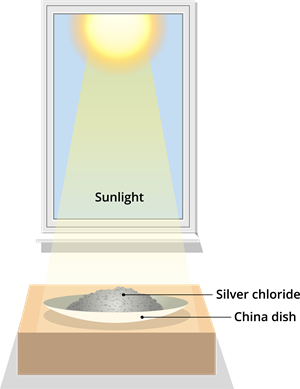
PUMPA - SMART LEARNING
எங்கள் ஆசிரியர்களுடன் 1-ஆன்-1 ஆலோசனை நேரத்தைப் பெறுங்கள். டாப்பர் ஆவதற்கு நாங்கள் பயிற்சி அளிப்போம்
Book Free DemoWe are performing this activity to understand the process of decomposition under suitable conditions (light).
Activity \(1.8\): Decomposition of silver chloride.
Materials required: -\(2\) g of Silver chloride
-China dish Experimental procedure:
Step 1: Take \(2\) g of silver chloride powder in the China dish.
Step 2: Place the China dish in sunlight for some time.
Note: After some time, check the silver chloride powder.
Observation:
- We observe that the colour of the silver chloride powder changes.
- There is an evolution of gas.

Decomposition of silver chloride
Result:
The colour of white silver chloride changes from white to grey due to the decomposition of silver chloride under sunlight. This grey powder is silver. And chlorine gets evolved as gas.
Decomposition reaction:
\(2AgCl\)(s) \(2Ag\)(s) + \(Cl_2\)(g)
(Silver chloride) (Silver) + (Chlorine)
Conclusion:
In this reaction, you can notice that a single reactant breaks down to give simpler products, known as a decomposition reaction. Now, here in this activity, silver chloride is decomposed into silver and chlorine under the sunlight.
Example:
Silver bromide also acts in the same way.
\(2AgBr\)(s) \(2Ag\)(s) + \(Br_2\)(g)
(Silver bromide) (Silver) + (Bromine)
The colour of pale yellow silver bromide changes from pale yellow to greyish white due to the decomposition of silver bromide under sunlight. The grey powder is silver. And the red-brown bromine gets evolved as gas.
The above reactions are done in black and white photography.
We have seen that the decomposition reactions need energy either in heat, light, or electricity to break down the reactants. Reactions in which energy is absorbed are called endothermic reactions.
Example:
Here, ammonium chloride is slightly acidic, and barium hydroxide is basic to get an acid-base reaction.
\(Ba(OH)_2\) + \(2NH_4Cl\) → \(BaCl_2\) + \(2NH_3\) + \(2H_2O\)
The reaction is highly endothermic (heat is absorbed during the reaction); If we place our palm on the bottom of the test tube, we feel cool.